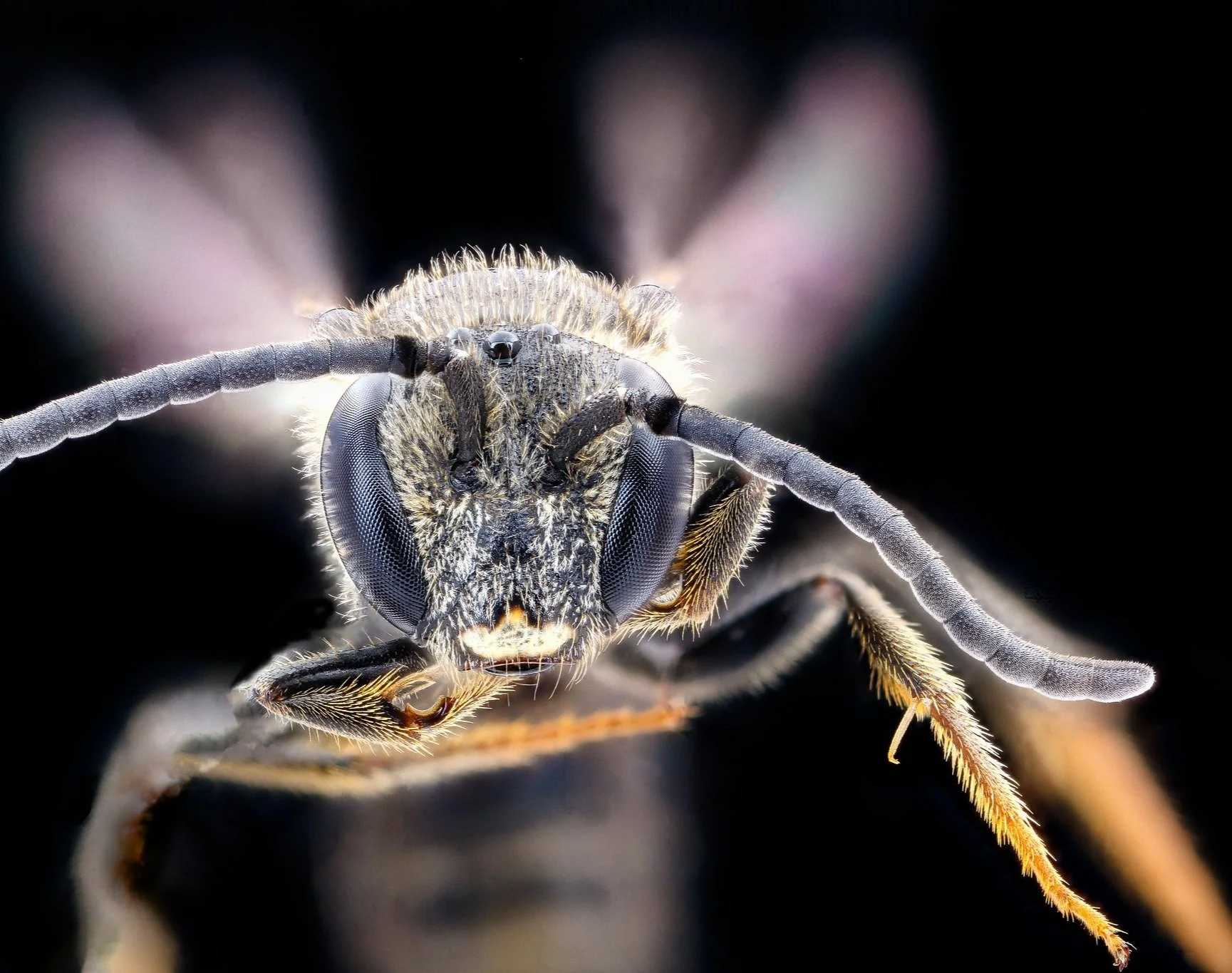the buzz about bees: why we need them & how to support them
by gretchen spencer
“By planting native plants, you are beginning to recreate things that are lost.”
– Sam Droege, Wildlife Biologist, Patuxent Wildlife Research Center
What are we doing in our own backyards to support native wildlife? That was the subject of an informative and engaging talk by wildlife biologist Sam Droege on January 30, 2022, sponsored by the Friends of Hollin Hills. A specialist in wild bees, Droege spoke about the vital role native plants play in supporting the wild bees and other wildlife in our area. His entire presentation can be found online (see the link at the end of this story), but here are some of the key points.
There are more than 450 kinds of native bees in our area, says Sam – and they are beneficial pollinators. They include mason bees, sweat bees, mining bees, leafcutter bees, bumblebees, and carpenter bees. But these native bees are very different from honeybees, which are not native and were introduced from Europe in the 17th century.
Native bees are small (sometimes tiny) and, for the most part, nest individually in the ground. They do not (and cannot) sting. Most of us would hardly know they are around! In the spring, you can find miner bees down along the stream in Paul Spring Park near the entrance across from Stafford Road. You can easily spot their small nesting mounds and holes in the sandy soil and often see them flying about.
Different species of native bees depend on particular native plants for nectar and pollen. Wild bees, like other insects, have specialized mouth parts that are matched to certain flower structures. They feed their larvae protein-rich pollen, and often pollen from only one specific type of plant.
Sam encouraged us to plant a variety of native flowering plants, including trees, in our yards that will bloom throughout the seasons and increase biodiversity in our landscape. His formula is “diversity of native plants equals diversity of native bees.” For example, one acre planted with a mix of flowering native plants can support up to 26,000 bees annually!
This relationship between native bees and native plants is also true for the many species of moths, butterflies and other insects that need native plants for survival, as they evolved together over time. For example, monarch butterflies will only lay its eggs on its native host plant, milkweed. And violets are the host plant for several species of fritillaries as well as providing nectar for mason bees.
Sam offered an easy way to convert a small portion of one’s yard or landscape to create “a small refuge” for insects and other wildlife.
First, use a weed whacker to cut back the grass as much as possible. You can create an outline of the bed with a hose or rope. Next, layer on eight inches of wood chips from a local tree company. This deep layer of chips will reconfigure your soil over time. There is an app called getchipdrop.com that provides information on signing up for free wood chips from local arborists. Or you can call your favorite tree company.
Bee nest in Paul Spring Park; photo by Elisabeth Lardner
Finally, make a hole and plant your plants through the mulch and into the soil. It might be a good idea to add some compost to the planting hole. Creating a bed in this way, without tilling the soil underneath, breaks up compaction, allows the soil to breathe, encourages healthy fungal and bacterial growth, retains water, increases carbon storage, and helps to control weeds.
Of course, Sam does not recommend the use of any chemicals or fertilizers. And he suggests homeowners not use mosquito control companies, as they kill all insects including the beneficial ones.
But why would we want more bugs in our yards? As Doug Tallamy notes in his seminal book Bringing Nature Home: How You Can Sustain Wildlife with Native Plants, of the four million or so insect species on earth, a mere one percent interact with humans in negative ways. The other 99 percent are beneficial. They pollinate plants, return nutrients to the soil from dead plants and animals, aerate the soil and enrich it, help to control insect pests, and provide food either directly or indirectly for most other animals.
Along with magnificent photographs of wild bees, Sam also shared pictures of native shrubs and flowers that attract not only wild bees, but other important pollinators such as butterflies, moths, birds, bats, beetles, and spiders, to name a few. According to the Piedmont Master Gardeners, natives that are loved by bees include easy-to-grow redbuds, blueberries, coreopsis, coneflowers, Joe Pye weed, asters, pentstemons, goldenrods, liatris, and bergamot. Two of the best sources of native plants are Plant Nova Natives and the Virginia Native Plant Society. Both websites offer a wealth of information about native plants.
Also, many local nurseries now tag native plants with special labels. And northern Virginia has two wonderful local native plant nurseries: Earth Sangha Wild Plant Nursery in Springfield and Nature by Design in Alexandria. In addition, there are several local native plant sales in the area each spring.
As spring is around the corner, we hope that many Hollin Hillers will either augment their existing gardens with native plants or create a new “wood chip bed” devoted to native plants to support and sustain not only native bees but all wildlife. We can each make a difference!
Sam’s online lecture, titled “What Is Your Yard Doing to Save Bees?” can be seen here.
The talk, sponsored by the Friends of Hollin Hills, followed on last year’s two talks on native trees and native shrubs given by Hollin Hills landscape architect Dennis Carmichael. Those talks can be seen by clicking here. If you are looking for native trees and shrubs to add to your landscape, consult these presentations!
– Gretchen Spencer, Popkins Lane




